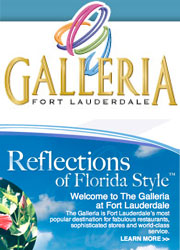For at least 5,000 years, people have been drawn to Fort Lauderdale. The prehistoric peoples of South Florida, known as the "Glades Culture," and the early historic period peoples of the area, the Tequesta, enjoyed the abundance of natural resources available along Fort Lauderdale's new River. By 1763, the last of these aboriginal peoples had left the area, and except for a few white settlers, Fort Lauderdale was devoid of population. The Seminole Indians first appeared in what is Broward County in the 1820s and were joined by a handful of white planters along the river.
The city of Fort Lauderdale is named for a Second Seminole War fortification built on the banks of New River in 1838. In that year, Major William Lauderdale led a detachment of Tennessee Volunteers south along the east coast of Florida to capture Seminole agricultural lands and battle the elusive Indian warriors. Altogether, three Fort Lauderdales would be constructed: the first at the fork of New River; the second at Tarpon Bend; and the largest on the beach at the site of today's Bahia Mar.
After the war, southeastern Florida remained a virtual wilderness due to the lack of transportation into the region. In 1892, however, the Dade County government authorized a rock road to be built between Lantana and Lemon City (North Miami). An over overnight camp and ferry crossing was established on New River, and a young Ohioan, Frank Stranahan, arrived to take charge of the facilities. He soon established a flourishing trading post with the local Seminoles and by 1895, Stranahan's Trading Post was a South Florida landmark.
In 1896, the Florida East Coast Railway was extended south through Fort Lauderdale, providing rapid transportation from all parts of the nation to south Florida. The little village increased in size and was incorporated in 1911. In 1915, Broward County was created out of parts of Dade and Palm Beach counties
The new county was named for Napoleon Bonaparte Broward who, as Governor of Florida, had begun a massive project aimed at dredging the Everglades. The Everglades survived this effort but canals that were constructed provided an efficient means for agricultural produce to be shipped to market. Fort Lauderdale became a major center for the shipping of winter fruits and vegetables north.
As Fort Lauderdale moved into the 1920s, it began to change from an agricultural community to a resort town. Population doubled and tripled in the early years of the decade, and many of the city's finest residential developments date from this era. Hopes for continued prosperity came to an abrupt end on the evening of September 18, 1926, however. On that date a deadly hurricane struck the south Florida coast; hundreds were killed and thousands of structures were destroyed I Fort Lauderdale, Hollywood and Miami. In the aftermath, many residents left never to return; south Florida was plunged into economic depression three years ahead of the rest of the nation.
Except for the completion of Port Everglades, the next decade and a half were quiet times for Fort Lauderdale. It was not until the Second World War that the local economy was revived. The war brought tens of thousands of service men to the region; the south Florida climate being deemed suitable for training facilities. Torpedo bomber pilots trained at today's Fort Lauderdale/Hollywood International Airport and submarine hunters ventured out of Port Everglades to do battle with German U-boats.
After the war many servicemen returned to Fort Lauderdale to resume their lives. For the next forty years, the city experienced unprecedented growth. New suburbs grew in the agricultural lands of western Broward County. Fort Lauderdale's annual College Swim Forum grew into the phenomenon of "Spring Break" that brought as many as 350,000 college students per year to the area at its peak in 1985.
By 1980, the city had achieved a population of over 150,000 making it the fifth largest city in the state; Broward's over one million residents make it Florida's second largest county. Today, Fort Lauderdale has become the regional governmental and commercial center for a major metropolitan area and is world famous as a tourist destination. All this in little more than a lifetime!
For more information please visit their website at www.fortlauderdalehistorycenter.org .
Stranahan: The Founder of the City of Fort Lauderdale
























